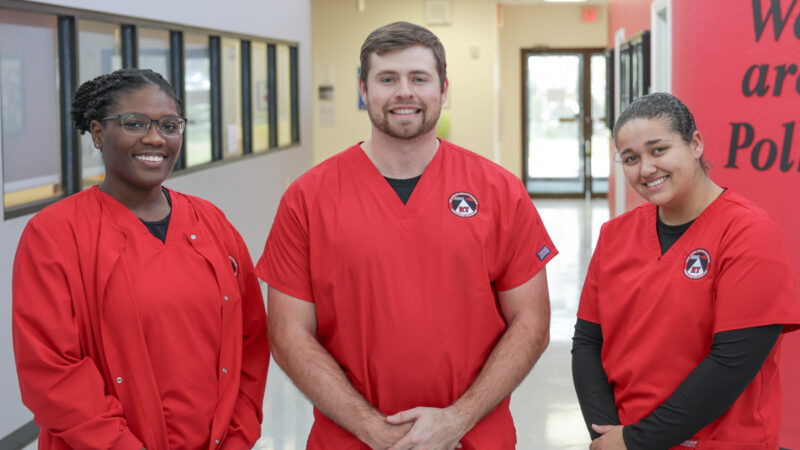Polk State Radiography embraces virtual reality technology

Faculty and staff with Polk State College’s Radiography Program are already reporting positive results after only weeks of offering virtual reality technology to their students.
Polk State’s Health Sciences programs have benefited from technology and equipment upgrades thanks to Higher Education Emergency Relief Funds (HEERF). The Radiography Program specifically has incorporated virtual reality (VR) headsets with medical simulation software that allow students to work in 3D and 2D settings at College’s Airside Center West. Two classrooms have been retrofitted to accommodate the technology. Students can also practice in 2D at their homes.
“The benefits have already been shown. Our instructors have reported positive feedback in the efficiency of exams [and] when students go to do checkoffs in the lab,” Radiography Program Director Jaime Selph said. “Their skills are much higher.”
Previously limited by space, time, and the number of X-ray machines, students can now build on their skills developed in class, clinicals, and the traditional lab setting by practicing in VR.
Virtual reality is a simulated experience that employs pose tracking and near-eye displays that gives users an immersive feel of a virtual world. Radiography students are supplementing what they are learning by simulating real patient scenarios and X-ray exposure without the radiation or the need to be physically in the X-ray lab for practice.
“Our labs and our instruction here at Polk State College remain on the cutting edge because our equipment is real-world. Our machines and simulators are very similar to what the students see in their clinical rotations and when they get into their careers,” Selph said. “VR technology allows the students to have more hands-on experiences without necessarily being in the X-ray lab.”
With recent enrollment growth and approximately 30 students admitted into the newest cohort, Selph explained the challenge of students sharing only two X-ray machines.
“Our labs and our instruction here at Polk State College remain on the cutting edge because our equipment is real-world. Our machines and simulators are very similar to what the students see in their clinical rotations and when they get into their careers.”
“Allowing them the use of VR technology not only here on campus but also at home allows them to practice as much as they want or need,” she added.
Students are already reporting the benefits.
“It allows you to have an idea of how to move the equipment and how to move the body,” Radiography student Matthew Brooks explained. “I find it very user-friendly. Once you have an idea of how the controls work, it’s super simple to use. When we don’t have more time in the (X-ray) lab, we can have more time in here to (practice).”
Student Tiarre Pierce echoed this appreciation for the new equipment and labs.
“It’s cool to get a different form of instruction; a different learning opportunity,” she said. “It’s giving us more opportunity for trial-and-error and to be able to improve from that.”
Students recommend Polk State Radiography to other aspiring radiologic technologists for many reasons including the technology, instructors, affordability, and quality.
“The program is a mix of all learning styles. You have your classroom instruction and your hands-on learning,” student Sarah Miller explained. “The teachers are also motivating and helpful. You can just tell that they are very passionate about what they do. A passionate professor is the key to success.”
With Polk State Radiography Program graduates boasting 100% pass rates on the credentialing exam and 100% job placement, the newly acquired equipment will only enhance the quality of radiologic technologists entering local healthcare facilities.
“The students are excited because they don’t have to sit in the lecture room; they can put what they are learning in action in multiple places,” Selph said. “The instructors are excited because they are seeing results already.”

